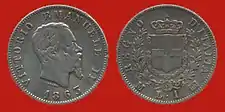Lira
Lira is the name of several currency units. It is the current currency of Turkey and also the local name of the currencies of Lebanon and Syria. It is the former currency of Italy, Malta, San Marino and Vatican City, all of which were replaced in 2002 with the euro, and of Israel, which replaced it with the old shekel in 1980. The term originates from the value of a troy pound (Latin libra) of high purity silver. The libra was the basis of the monetary system of the Roman Empire. When Europe resumed a monetary system, during the Carolingian Empire, the Roman system was adopted, the so-called £sd (librae, solidi, denarii).
| 100 Italian lira (1979, FAO celebration) | |
|---|---|
.jpg.webp) | |
| Obverse: Young woman with braid facing left and Repubblica Italiana (Republic of Italy) written in Italian. | Reverse: Cow nursing calf, face value & date. FAO at bottom and Nutrire il Mondo (English: Feed the world) at top. |
| Coin minted by Italy in 1970s to celebrate and promote the Food and Agriculture Organization. | |
| 1 Turkish lira (2009) | |
|---|---|
 | |
| Obverse: Mustafa Kemal Atatürk with "TÜRKİYE CUMHURİYETİ" lettering (Republic of Turkey) | |
| 1 Italian lira (1863) | |
|---|---|
 | |
| Obverse: Victor Emmanuel II | Reverse: Coat of arms of the House of Savoy |
| 10 Turkish lira (1986) | |
|---|---|
.jpg.webp) | |
| Obverse: Mustafa Kemal Atatürk with "TÜRKİYE CUMHURİYETİ" lettering (Republic of Turkey) | Reverse: Face value and year within wreath, crescent moon and star at the top. Crescent opens right |
Particularly this system was kept during the Middle Ages and Modern Age in England, France, and Italy. In each of these countries the libra was translated into local language: pound in England, livre in France, lira in Italy. The Venetian lira was one of the currencies in use in Italy and due to the economic power of the Venetian Republic a popular currency in the Eastern Mediterranean trade.
During the 19th century, Egypt and the Ottoman Empire adopted the lira as their national currency, equivalent to 100 piasters or kuruş. When the Ottoman Empire collapsed in years 1918–1922, many among the successor states kept the lira as their national currency. In some countries, such as Cyprus, which have belonged to both the Ottoman Empire and the British Empire, the words lira and pound are used interchangeably.
Lira sign
For Turkish lira, the Turkish lira sign (₺) is used. The Lebanese pound (also known as lira) uses ل.ل.. The Syrian pound (Lira, in Arabic) uses £S.
The primary symbol for the Italian lira was L. but the symbols ₤ (two bars), £ (Unicode 'POUND SIGN', one bar) and prefix "Lit." were common.
The Unicode system allocates U+20A4 ₤ LIRA SIGN to the Lira. (Contrast may be drawn with U+00A3 £ POUND SIGN, where the one-bar and the two-bar versions are treated as allographs and the choice between them is merely stylistic).
Other uses
The Carl Lindström Company and its subsidiary Parlophone Records used the ₤ symbol in a circle as its trademark, but it is a stylised blackletter L (, for Lindström) rather than a currency symbol.
Current uses
Turkey
The Turkish lira was introduced in 1844 during the Ottoman reign. The Turkish Lira is now the currency of Turkey and the Turkish Republic of Northern Cyprus.
Lebanon and Syria
The Lebanese pound and Syrian pound are both called "lira" (ليرة) in Arabic, the national language of both Lebanon and Syria.
Former currencies
- Cypriot pound, or lira, 1879–2007
- French livre 781–1794
- Israeli pound (known as לירה "lira" in Hebrew) 1948–1980
- Italian lira 1861–2002
- Italian East African lira 1938–1941
- Italian Somaliland lira 1925–1926
- Luccan pound, or lira, until 1800 and 1826–1847
- Maltese lira 1825–2007
- Neapolitan lira 1812–1813
- Ottoman lira 1844–1923
- Papal lira 1866–1870
- Parman lira before 1802 and 1815–1859
- Sammarinese lira 1860s–2002
- Sardinian lira 1816–1861
- Tripolitanian lira 1943–1951
- Tuscan pound, or lira, until 1807 and 1814–1826
- Vatican lira 1929–2002
- Venetian lira 1472–1807
- Pound (currency), translated "lira" in some languages
Further reading
- Carlo M. Cipolla, Le avventure della lira, Bologna, Il Mulino, 1975.
- Stefano Poddi, "La lunga storia della lira", stralcio, Fondazioni, n. 2 marzo-aprile, 2008. Roma.
- Stefano Poddi, "La lunga storia della lira", articolo completo, Difesa e Lavoro, settembre 2008.